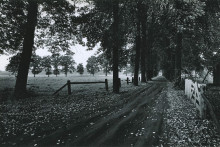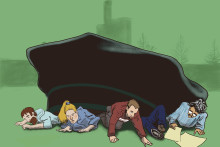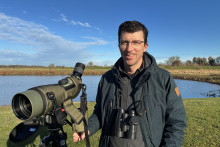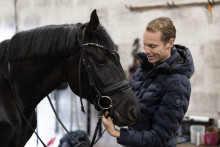Two parts
On 4 and 5 May U-Today brings you a story about the history of the country estate of Drienerlo, which spans two-thirds of the current campus. Why? Because World War II was decisive for the fate of Drienerlo.
Tomorrow, an extensive profile of Gerrit Albertus Lasonder will follow, a former alderman of Education and Nazi sympathizer, who owned the country estate of Drienerlo before and during the Second World War.
Gerrit Lasonder died in 1944 of kidney disease. He was married to German Anne Christine Bauer, ten years his junior. She came from a family of ardent Hitler supporters. After Lasonder's death, she was the sole beneficiary of an estate worth some 2,300,000 guilders. As the Allies approached, however, the widow fled to Gildehaus, leaving the Drienerlo estate unattended.
Dutch National Socialist Movement, the NSB
One thing soon became apparent in the period following the war: as the property of a late NSB member, the estate was not going to be allowed to remain in the hands of Mrs Lasonder, who, to make matters worse, was of German descent in any case. In 1947 her entire estate was confiscated following a Tribunal order. Mrs Lasonder herself was never involved in this expropriation procedure. One of the considerations during the trial was that Lasonder himself deeply wronged the Dutch people with proven wartime actions Furthermore, the legal heiress no longer held Dutch nationality as every wartime marriage was declared null and void at that time. The Tribunal declared the whole of the fortune to be enemy assets. This meant the State could confiscate it.
In November of 1947, the municipality of Enschede acquired the estate for 183,690 guilders, a pittance. After its purchase, it became a recreational area. For years, part of it was used as a playing field, and the park-like landscape provided the people of Enschede with beautiful walking trails. However, that was not the purpose the municipality had in mind.
 This is how the landscape looked from above before the THT arrived here (Historisch Archief)
This is how the landscape looked from above before the THT arrived here (Historisch Archief)
Lobbying for the third polytechnic university
The intended purpose was to establish a training institute for the Foreign Service (the NOIB), but that soon proved fruitless. The NOIB was accommodated in Nijenrode Castle. At that time, an increasing number of voices called for a second polytechnic university (TH) in Enschede. However, the second TH went to Eindhoven (in 1957), and the educational plans had to be put on hold for the time being. However, when it became clear that there was room for a third polytechnic university, Enschede once again joined the ranks.
The Minister of Education at the time, Minister Cals, ignored the advice of the so-called distribution committee, which appointed Deventer. Cals chose Enschede, with the availability of a country estate as an overriding consideration. The Minister submitted a memorandum to the House of Representatives on 25 January 1961. At the end of that year, the House agreed to the amendment of legislation which officially added Enschede to the existing THs of Delft and Eindhoven. Meanwhile, the municipality had already decided to present Drienerlo 'as a gift' to the State. A Committee for the Preparation of the third polytechnic university was founded.
Farming families
Three farming families were not so happy with the arrival of the third TH. Their farms, including land earmarked for the development, fell under the confiscation of the entire estate and thus became the property of the Technische Hogeschool Twente, the THT. One farm had to be removed altogether to make way for the Mechanical Engineering building. Scholten's farm was retained; for many years it housed the Communication Department and it is currently home to the Faculty Club. Farmer Bosch was permitted to reside on the campus. When the principal occupants died, the UT took over its management. The staff association UT Kring has been based there since 1995.
With the realization of the THT and the accompanying campus, most of the estate vanished. Mrs Lasonder was rehabilitated in 1969 (see also Lasonder profile). She was ultimately satisfied with the transformation of the estate into a campus - the educational re-purposing of Drienerlo was wholly in the spirit of her late husband, the former alderman of Education.
This article was previously published in UT Nieuws Magazine May 2015 (you can also find an extensive citation overview here).







